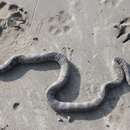en
names in breadcrumbs


Leviton et al. (2003) provide a technical description of this dangerously venomous snake: Scales on thickest part of body quadrangular or hexagonal in shape, feebly imbricate or juxtaposed. 14-18 maxillary teeth behind front fangs; 2 anterior temporals. Scales in 31-43 rows on the neck, 38-54 around midbody (increase from neck to midbody 6-14); ventrals 253-334, distinct throughout though not twice as large as adjacent body scales; bluish gray above, whitish below, with 40-60 broad bands, about twice as wide as interspaces, tapering ventrally (in older adults, bands become indistinct).
According to Leviton et al. (2003), Hydrophis caerulescens occurs in Myanmar [Myanmar]coastal waters, where it is especially abundant in the Mergui Archipelago (Tanintharyi Division). This species also occurs on both the west and east coasts of India (vicinity of Bombay and Karwar in the west and from Madras to the mouth of the Ganges on the east coast) east through Straits of Malacca to the Gulf of Siam [=Gulf of Thailand] to southeastern China and western Indonesia. The habitat has not been described (Leviton et al. 2003).According to Kharin (2004), this species is found along the eastern coast of India, coastal areas of Ceylon [Sri Lanka] and Burma [Myanmar], the Straits of Malacca, the Gulfs of Thailand and Tonkin, the Yellow Sea, coastal areas of Java and Kalimantan, and the Gulf of Carpentaria.
This species was referred to the new genus Polyodontognathus by Kharin (2004).
Marine waters of Pakistan, India, Gulf of Thailand, and southern China through Indonesia to the Moluccas and northern Australia (southeastern Gulf of Carpentaria).
Holotype: BMNH 1946.1.3.90 (formerly BMNH iii.6.13a).
Type-locality: East-Indian Ocean [label on holotype states Indian Ocean: Vizagapatam].
Hydrophis caerulescens, commonly known as the dwarf sea snake, is a species of venomous sea snake in the family Elapidae.[2]
Indian Ocean (Pakistan, India, Bangladesh, Myanmar (Burma), Thailand, W Indonesia, Malaysia), Coasts of Shandong and Guangdong (China), South China Sea, Australia (Queensland), New Caledonia/Loyalty Islands.
The dwarf sea snake is bluish or grayish blue dorsally, merging to yellowish ventrally, with 35-58 deep bluish-black crossbands. The crossbands are as wide or wider than the interspaces, well defined in younger specimens, but obscure in older specimens. The head is black, and in juveniles may also have a yellowish horseshoe-shaped mark.
Adults may attain a total length of 74 cm (2 ft 5 in).
The dorsal scales are arranged in 38-54 rows at midbody (31-43 rows on the neck). Ventrals 253–334.[3]
Each hollow poison fang is followed by a series of 14-18 solid maxillary teeth. The dorsal scales on the thickest part of the body are quadrangular or hexagonal in shape, feebly imbricate (overlapping) or juxtaposed. The ventrals are almost twice as large as the adjacent body scales.
Head very small. Anterior part of body very slender, its diameter about one third the diameter of the posterior part. Rostral broader than deep. Frontal longer than broad, shorter than its distance from the rostral, much shorter than the parietals. One preocular, and one post ocular. Two superposed anterior temporals. Seven upper labials, the third and fourth entering the eye. Chin shields very small, the posterior pair separated by scales. Ventrals distinct throughout the entire body length.[4]
Hydrophis caerulescens, commonly known as the dwarf sea snake, is a species of venomous sea snake in the family Elapidae.
Hydrophis caerulescens Hydrophis generoko animalia da. Narrastien barruko Hydrophiidae familian sailkatuta dago.
Hydrophis caerulescens Hydrophis generoko animalia da. Narrastien barruko Hydrophiidae familian sailkatuta dago.
Hydrophis caerulescens ou Hydrophide azuré est une espèce de serpents de la famille des Elapidae[1].
Cette espèce marine se rencontre dans le nord de l'océan Indien et l'ouest du océan Pacifique dans les eaux du Pakistan, de l'Inde, de la Birmanie, de la Thaïlande, de la Malaisie, du Viêt Nam, de Chine, de l'Indonésie, du Queensland et de Nouvelle-Calédonie[1].
On la trouve sur les fonds vaseux ou herbeux jusqu'à 25 m de profondeur et, pendant la mousson, près des estuaires, dans les rochers et les coraux.
L'hydrophide azuré est un serpent marin venimeux qui mesure de 70 à 80 cm de long. Il est de couleur gris-noir, avec des taches plus claires.
Il mange en particulier des poissons anguilliformes et de petits crustacés.
Il est peu agressif, sauf si on le prend dans sa main, et il y a donc peu de morsure[2].
Selon Reptarium Reptile Database (7 janvier 2013)[3] :
Cette espèce a été placée dans le genre monotypique Polyodontognathus[4] son inclusion dans Hydrophis' a été confirmée par Sanders, Lee, Mumpuni, Bertozzi et Rasmussen en 2012[5].
Hydrophis caerulescens est species Serpentium marinorum familiae Hydrophiidarum.[1]
Hic anguis est in Oceano Indico (Pakistania, India, Birmania, Thailandia, Indonesia occidentali, Malaesia), litoribus Shandong et Quantuniae (Sinarum), Mari Sinae Meridianae, Australia (Terra Reginae), Nova Caledonia (Insulis Fidelitatis) endemicus.
Hydrophis caerulescens est species Serpentium marinorum familiae Hydrophiidarum.
Hydrophis caerulescens là một loài rắn trong họ Rắn hổ. Loài này được Shaw mô tả khoa học đầu tiên năm 1802.
青灰海蛇(学名:Hydrophis caerulescens)为眼镜蛇科海蛇属的爬行动物。分布于从印度洋经南中国海至印度尼西亚到澳大利亚以及中国大陆的台湾及山东沿海等地。该物种的模式产地在印度洋Vizagapatam。[1]